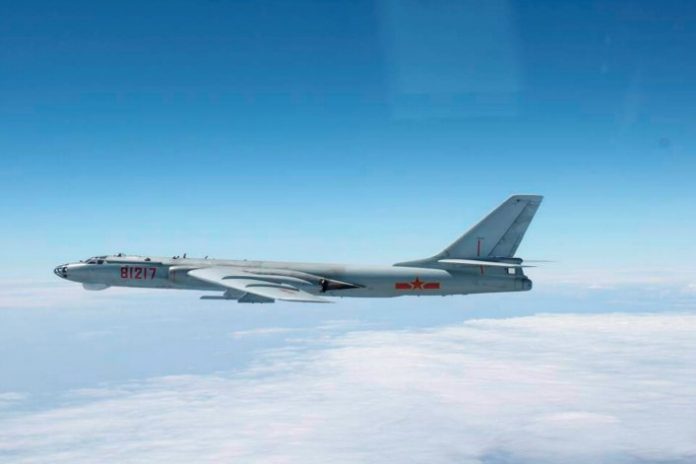
Chinese officials warned Monday that relations with the U.S. may fall apart if President-elect Donald Trump does not respect China’s “core interests” going forward. The comments were made in response to Trump’s now-infamous phone call with Taiwan’s president.
“I want to stress that the Taiwan issue concerns China’s sovereignty and territorial integrity, and involves China’s core interests,” ministry spokesman Geng Shuang said during a news briefing. “Upholding the ‘One China’ principle is the political basis for developing China-U.S. ties. If this basis is interfered with or damaged, then the healthy development of China-U.S. relations and bilateral cooperation in important areas is out of the question.”
The warning comes hours after reports emerged indicating China flew a nuclear-capable bomber over a disputed part of the South China Sea, in a move U.S. officials say was meant to send a message to Trump. The Xian H-6 bomber, at times accompanied by fighter jets, flew along the demarcation line between China and disputed territories, including Taiwan, Fox News reported, citing U.S. officials. Pentagon officials reportedly found out about the nuclear bomber’s flight Friday, though it was not immediately clear when the flight took place. Officials have warned the flight was the first of its kind in more than 18 months. Read more.
{Matzav.com}












Yes, there is a “One China Policy”: The one government of China is the one that has been the government of China since its inception in 1911 upon the collapse the previous royal dynasty. It is called the “Republic of China” – the “ROC,” and its political party is called the “Nationalist Party.” It was founded by a Chinese medical doctor, Sun Yat-sen, and after his death in 1925, it was led by one of his lieutenants, Chiang Kai-shek. [See https://en.wikipedia.org/wiki/Republic_of_China_(1912%E2%80%9349) and the several links there for the numerous complex details of these developments.]
In 1920, a small Communist party was formed; its eventual leader was a son of a farming family, Mao Zedong. At first, it was part of the Nationalist Party, but later, Chiang Kai-shek expelled it. By 1927, severely deadly attacks of each side against the other developed into a terrible endless civil war. In 1937 though, Japan — which in 1931 had already occupied the large north-eastern province called “Manchuria” — would soon move south into China proper. The Communists kidnapped Chaing and forced him to agree to stop fighting them, and to instead, fight the Japanese. So for World War II, they had an uneasy alliance, and the United States gave them tremendous amounts of aid.
Then, in August & September of 1945, was the U.S. – Allied victory over Japan, and thus the Japanese were no longer in China. (A copy of the famous picture of Chaing Kai-shek and Mao Zedong, each with beaming smiles, toasting each other at a victory celebration, can be seen at
http://xenohistorian.faithweb.com/china/MaoChiang1946.jpg?vm=r&s=1.) The U.S. attempted to keep further “peace” between Chaing Kai-shek and Mao Zedong, but that was an impossibility, as the old Nationalist against Communist civil war re-erupted with the fullest vengence.
At first, the Nationalists seemed to have big advantages as they had: three times as many soldiers, extensive heavy modern arms from the U.S., and control of the cities. However, the cohesion of their leadership was poor, and there was widespread corruption in their ranks; the bulk of the soldiers were, understandably, tired and worn out from the years of war against Japan, and were weakly motivated for this new crusade. So, countless times, when faced with a fight, scores of soldiers actually defected to the Communists! By contrast, (during WWII) when battle with the Japanese was on the horizon, the Communists — very shrewdly — very often managed to slip off into the countryside and let the Nationalists do all the work! Furthermore — like countless other evil tyrannical leaders throughout history — Mao Zedong, Yimach Shemo V’Zichro, had the the fantastic talent of being able to falsely convince the vast masses of the rural countryside population the total lie that “he was on ‘their side'” and that “he was fighting ‘for them'”! In fact, he eventually called his forces the “People’s Liberation Army”!
So pretty soon, the tide of the renewed civil war began to turn as the Communists gained the momentum. More and more, they conquered city after city and province after province until by 1949, they had conquered the entire Chinese mainland. In 1950, they further conquered the large island of Hainan, located right off the south coast, and invaded (what had hitherto been) the separate country of Tibet and annexed it to the south-west part of the county. On October 1, 1949, 8 Tishrei, 5710 — two days before Yom Kippur — in, what would be the new capital city, Bejing, Mao officially declared the new Communist Chinese country. He actually used the exact same name as the name of the Nationalist’s one: the “Republic of China,” only he added one more word, thus giving: the “People’s Republic of China”!
On December 7, 1949, Chaing Kai-shek and about two million of his supporters managed to escape capture as they fled from the mainland to the large island of Taiwan, located 110 miles away from the southeastern mainland coast. Taiwan thus became now the main location of the Republic of China, and its capital city of Taipei became the “temporary” capital of the Republic of China. Besides the island of Taiwan itself, the Nationalists also control several tiny islands right next to the mainland coast and out in the South China Sea.
Understandably, Chaing Kai-shek had vowed to someday return and liberate the mainland. His goal was strongly advocated by arch conservative political and military leaders in the United States, most notably the famous General Douglas MacArthur (who had been the main leader of the U.S. effort of the WWII War in the Pacific and the initial leader of the U.S. led United Nations effort of the Korean War). However, the decided-upon-policy of the U.S. government did not support such an effort, but rather worked to preserve the status quo. Ships from the U.S. Navy were positioned in the ocean strait between the mainland and Taiwan to both prevent the Communists from attempting to go also conquer Taiwan AND to also prevent the Nationalists from attempting to go retake the mainland.
For the early part of the Cold War through the 1950’s and the 1960’s, most non-Communist countries continued to recognize the Nationalist’s Republic of China as THE one legitimate China. However, in the 1970’s, this sharply changed. In 1971, the United Nations, switched its “China seat” from the Nationalist’s Republic of China to the Communist’s People’s Republic of China; this action thus meant that the Nationalist’s China was expelled from the U.N. Through the 70’s decade, most countries — including the United States in 1979 — switched their recognition of the one legitimate China from being the Nationalist’s Republic of China to the Communist’s People’s Republic of China. Therefore, the Communist’s China is no longer referred to as “Communist China” or “Red China,” but instead, just plain “China.”
Furthermore, the Communist’s People’s Republic of China – the PRC, has rigid demands for those who want to be its friends. A country that wants to have diplomatic relations with it must absolutely then have no recognitions whatsoever of the Nationalist’s thing. Also, that country that is now recognizing the PRC as being the one only legitimate China must also recognize that the PRC also owns the island of Taiwan and that the Nationalist’s thing there is illegal and makes Taiwan a “renegade province.” Most countries (who recognize and have diplomacy with the PRC) though, while they do not have any “formal” “official” diplomatic relations with the Nationalists, still do have “IN-formal” and “UN-official” relations with them with what can be termed “de facto” embassies and consulates.
The United States, while, as said above, in 1979 did recognize and establish formal diplomatic relations with the PRC, has still maintained very strong informal ties with Taiwan and has still refused to accede to the PRC’s demand of recognizing its ownership of Taiwan. Instead, the U.S.’s position has been that the issue must be decided — in complete accordance with the will of the people of Taiwan — completely PEACEFULLY with no force or threats or pressure or coercion whatsoever. If the PRC were to attempt to invade or attack Taiwan, the U.S. would do whatever militarily intervention is needed to fully defend Taiwan. The U.S. has thus continued to provide Taiwan with significant amounts of defensive weapons; at the same time though, it has also advised Taiwan to refrain from any action that would provoke the PRC. (See full discussion at https://en.wikipedia.org/wiki/Taiwan and the link there to https://en.wikipedia.org/wiki/Taiwan_Relations_Act.)